“Did everyone arrive at the top safely?” Not the most common question when visiting the construction site of a greenhouse. Yet it was a logical question after about 60 people climbed the stairs to the top of REO Veiling’s crate warehouse to witness the start of the construction of rooftop greenhouse Agrotopia of Inagro. With the construction, Roeselare will get an innovation centre focused on the future, and moreover, they’ll get a proper landmark right by the motorway.
Please click here for the photo report.

Bart Naeyaert (deputy Agriculture and Fisheries West Flanders), Paul Demyttenaere (REO Veiling), Mia Demeulemeester (Inagro) and Rita Démare (REO Veiling).
9,500 square metres
It took a while before the construction could definitively be started. “Finally,” was therefore often heard. Late 2018, the crate warehouse, which has now been in use for two years, could finally be made ready for carrying the greenhouse. Soil and sewer activities came first, five silos were constructed for the supply of water, and the next phase was started this week: the construction of a rooftop greenhouse of 9,500 square metres.
Eventually - oh irony - construction commenced on exactly the same date as last year Dutch rooftop greenhouse De Schilde was declared bankrupt. However, the two complexes are nothing alike. Whereas De Schilde acted as a commercial greenhouse, the Belgium rooftop farm will serve as a research greenhouse.
During the official laying of the foundation stone, deputy Bart Naeyaert emphasized the importance of the project for the greenhouse horticulture sector.
In the rooftop greenhouse Belgium organisation Inagro will conduct practical research on horticulture within the city. The rooftop greenhouse is to be an example of integrating food production in urban areas.
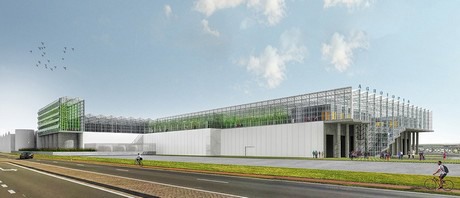
It took quite a bit of imagination to actually see a greenhouse this week, and it helped to have an artist impression. The design is by Van Bergen Kolpa Architecten in cooperation with co-architect Meta Architectuurbureau.
The 9,500 m² building will house high-tech research facilities and will include an educational route for a wider audience. Approximately 6,000 m2 is reserved for cultivation compartments for research that must provide answers to current and future questions about hydroponic grown leaf and fruit vegetables.
Various hydroponics systems are given a place in the compartments, including installations for closed multi-layer cultivation with LED lighting. High vertical cultivation will be discussed in the facade greenhouse, with a height of 12 meter
In addition to research and development, demonstration will also be an important function of the roof greenhouse. For example, Agrotopia must give space to a living lab, both literally and figuratively.
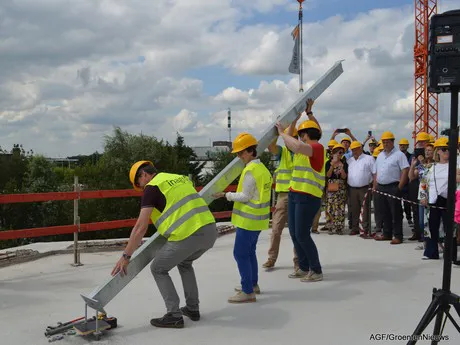
The pile was placed uptight by united effort. In the background, the pipeline of waste incinerator MIROM can be seen, which will supply residual heat to the rooftop greenhouse.
Efficient use of space and energy
Piles don’t have to be driven into the ground of course, but to still have an official start, the deputy of West Flanders for Agriculture and Fisheries, Bart Naeyaert, could hold a pile upright and drill it into place. He naturally didn’t do that without giving a short speech to the people present first, and thanking all of the parties involved. During his short speech, Naeyaert mentioned that the use of space and energy is as efficient as possible.
Residual heat
The space spoke for itself on top of the roof, but the energy needs a bit more explanation. The greenhouse will use residual heat from REO Veiling, but also from nearby waste incinerator MIROM. The flue gases are not (yet) used now, but people are already in talks regarding this. In any case, the greenhouse will also have a compartment with the necessary pipe system to conduct tests with the external CO2, according to Peter Bleyaert of Inagro during a tour of the site. “We’re still seeing a lot of growers who aren’t completely convinced they can use the flue gases of these kinds of sources safely. Growers want proof first, and testing can help in that.”
Landmark with appeal
Naeyaert also talked about the importance of the rooftop greenhouse as landmark. Part of the greenhouse will be 12 metres high, and as it’s right by the motorway, it should become a symbol for the attention paid to greenhouse horticulture by the region. “That is something that could be shown more often,” Naeyaert says.
Mia Demeulemeester of Inagro also spoke before construction got started. She was naturally also proud of the project, which, according to her, is important to continue to be a part of the developments in greenhouse horticulture that are following each other in rapid succession, specifically regarding production in cities. “Since it became known that this building will feature a rooftop greenhouse, we managed to make a lot of additional contacts with parties interested in urban production in particular, even though the greenhouse isn’t even finished yet.”
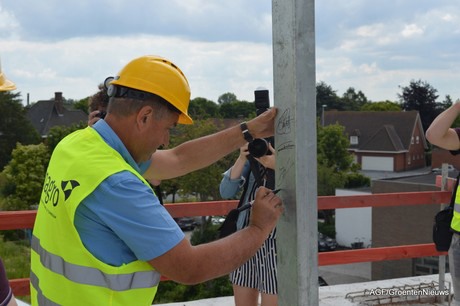
Once the pile was upright, it could be signed by anyone interested. Pictured is Paul Demyttenaere of REO Veiling.
Staying connected to developments in the sector
The knowledge acquired in the greenhouse, which should be operational late in 2020, will be shared with the sector. It’s also Inagro’s aim to strengthen the ties with growers thanks to the location near the auction. Bart Verhaeghen of Inagro: “We now organise a lot for growers, but we can do that even more soon. Thanks to our state-of-the-art facilities, our tests will connect to modern facilities and the accompanying methods of production of progressive growers even more. It’s a method of growing we would like to introduce to the general public, so we’ll also have a visitor corridor to introduce people to the manner of production of the future.”
Please click here for the photo report.
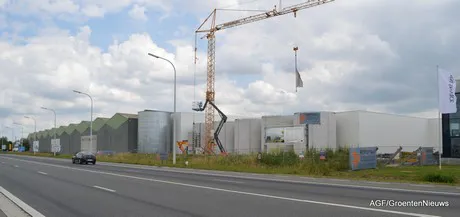
This is what it looks like from the motorway now.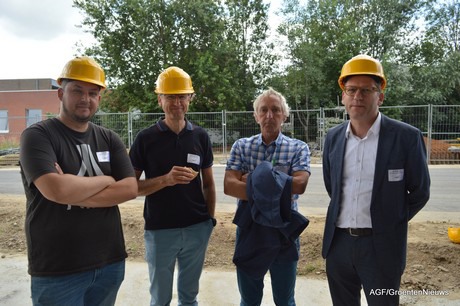
Stijn Cappon (Deforche Construct), Francis Vancraeynest (Deforche Construct), Johan Vermeulen (Maïs Automatisering) and Jago van Bergen (Van Bergen Kolpa Architecten). Deforche will construct the greenhouse, Maïs Automatisering will take care of technical aspects of the greenhouse, and Van Bergen Kolpa Architecten came up with the serrated façade and the 12-metre high greenhouse as a landmark.
For more information:
Inagro
www.inagro.be
[email protected]
